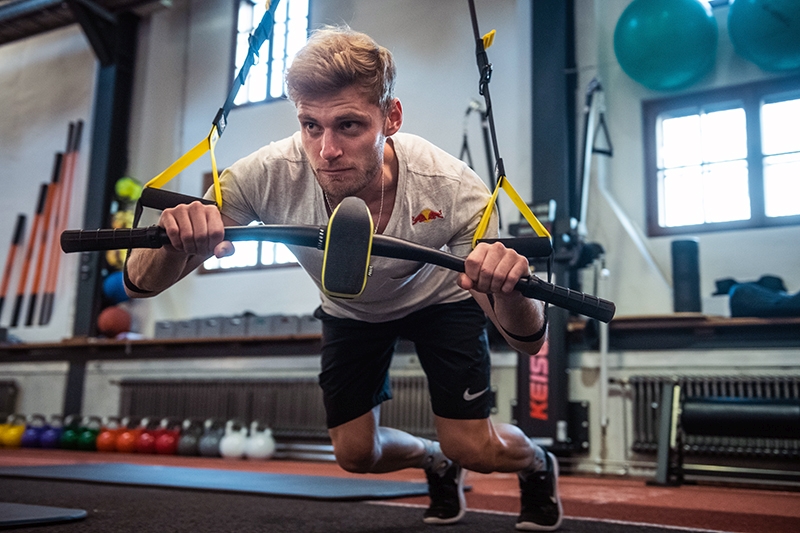You are viewing 1 of your 1 free articles. For unlimited access take a risk-free trial
Strength training for sport: let repetition speed guide you

New research suggests that the change in rep speed during strength training can be harnessed to an athlete’s advantage
While the rationale for strength training seems relatively straight forward, its benefits and execution are often a topic of disagreement among athletes and coaches. Even the strongest advocates for regular strength work often struggle to agree on what is the best approach. However, a new approach has recently emerged, which has the potential to allow athletes to get all of the strength training benefits with none of the potential drawbacks.Fixed reps, fixed load
Traditional strength training has focused heavily on conducting a pre-determined number of repetitions while using a pre-determined load. More recently, there has been a growing interesting in using the speed of the repetition as a primary determinant of how strength training is conducted. Although there is research indicating that the speed of the load can be used to determine the weight to use, we’re going to focus on using the repetition speed - specifically how speed changes over the course of a set - to determine the optimal number of repetitions to perform in a set.With this new approach, training sets are not performed with a pre-determined number of repetitions. Instead, the velocity loss (ie slowing of the exercise movement) over the course of a set will determine when the set is finished. Once a certain percentage of the initial speed is lost, the set is over. For example, if the initial reps are performed at 1.0 meters/second, the set will continue until the athlete can no longer maintain a velocity of 0.7 meters/second. Velocity loss is really a measure of how much fatigue has been generated over the course of the set. As greater velocity loss implies greater fatigue, measuring the velocity loss is really about measuring, and controlling, fatigue. By limiting velocity loss, you limit the fatigue that’s created.
The research on velocity loss
Having established the background for using velocity loss to optimize strength training implementation, let’s see what the research says about using different velocity loss percentages. In a recent study, the impact of training to 20% versus 40% velocity loss (VL) on a subsequent endurance training session was compared (1). As compared to the 20%VL protocol, running time was significantly slower during a subsequent endurance training session following the 40%VL training. In other words, performing more reps at the end of the set (by allowing greater velocity drop) resulted in poorer performance.What about long-term strength adaptations using this approach? In a very recent study, researchers had participants perform leg extensions and leg presses with one leg at a time(2). One leg was trained using a 15%VL and the other used 30%VL (ie more reps causing a greater slowing and more fatigue). When comparing measures of hypertrophy, power, and strength, there were no differences in improvement between the two protocols over the course of the study. The 30%VL simply induced extra work and extra fatigue.
When it comes to the upper body strength, a separate study investigated the impact of various velocity protocols on bench press performance(3). Over an 8-week period, the subjects trained using a velocity loss of 0% (ie stopping as soon as rep speed slowed), 15%, 25%, or 50%. The results indicated that higher VL thresholds led to more significant increases in hypertrophy whereas lower VL threshold led to improvements in neuromuscular variables such as rate of force production – an important quality for athletes performing dynamic movements.
A similar program was also used for the lower body, with a training program consisting of squats performed twice per week(4). The groups were divided into velocity loss thresholds of 0, 10, 20, and 40%. The results showed there were no differences in sprint, jump, or strength performance between the groups, despite the extra work performed by the higher VL groups. However, measures of muscle growth were greatest in the VL20 and VL40 groups. Having noted this, the VL40 group actually demonstrated decreased rate of force production - a potential negative impact of strength training that is too aggressive.
Speed
When it comes to speed benefits, one study found that smaller VL protocols preferentially improve sprinting performance as compared to larger VL protocols(5). When comparing velocity losses of 10%, 30%, and 45%, sprint times were lower by 0.5, 1.8 and 2.4% respectively. This is yet another example where less work leads to more results! Remember that for many athletes, improved speed is what is sought when focusing on strength training; these results indicate that how an athlete performs his or her strength performance can have a major impact on this outcome.Overall, there seems to be a compelling argument that higher VL protocols can impair short-term performance without providing additional benefits to strength and power development. For muscle growth, there is less certainty about which VL protocol works best. But as most athletes are not actively pursuing muscle hypertrophy as their main goal, the latter might not even be an issue.
Combining strength and endurance
The research above examined isolated endurance and isolated strength training programs. What happens in a concurrent training program, similar to that undertaken by many athletes? Fortunately, researchers sought to answer this question and have come up with some answers(6). Their study consisted of three different training groups:- An endurance only training group.
- A group that performed resistance training to a 15% velocity loss in combination with endurance training.
- A group that performed resistance training to a 30% velocity loss in combination with endurance training.
Most interesting of all, the VL15% group improved the velocity at maximal oxygen uptake to a greater degree than all the other groups (see figure 1). As the velocity at maximal oxygen uptake is an excellent indicator of endurance performance, these results imply that the VL15% was able to improve endurance performance more than the other training approaches. From a performance perspective, we can conclude that for endurance athletes in particular, while including some resistance training is more beneficial than performing no resistance training at all, performing strength training that is too strenuous is equally ill advised. Just like Goldilocks, the training needs to be just right!
Figure 1: Change in velocity at maximal oxygen uptake

Blue bars = pre training; green bars = post training. The 15%VL subjects increased their velocity at maximal oxygen uptake by 0.9 metres per second, a significantly greater increase than the endurance-only (0.4m/s) and 45%VL (0.5m/s) groups.
Getting practical
Here are some practical guidelines that flow from this research:Endurance
- When prioritizing endurance training, ensure that you’re limiting velocity losses to optimize your progress.
- Similarly, when prioritizing higher-quality speed and power adaptations (whether running, cycling, or swimming), stick to small velocity losses.
- If you’re objectively monitoring the velocity of your strength exercises, limit sets to velocity losses of 10-20%. If you relying on your own sensations, once you perceive a noticeable loss of velocity, stop your set and rest to allow for recovery. While this may feel too easy, you should trust the research.
Maximum muscle growth and strength
- If you’re really focused on maximizing hypertrophy, you can work towards greater velocity losses of up to 40-50%.
- If you’re not monitoring speed objectively, pay attention to when you consciously notice your speed begins to slow, and perform 1-3 more reps, while avoiding extremely slow repetitions.
References
- Int J Sports Physiol Perform. 2021 Feb 4;16(6):811-817
- J Strength Cond Res. 2021 Jun 7. doi: 10.1519/JSC.0000000000004067. Online ahead of print
- Scand J Med Sci Sports. 2020 Nov;30(11):2154-2166
- Med Sci Sports Exerc. 2020 Aug;52(8):1752-1762
- Scand J Med Sci Sports. 2021 Apr 7. doi: 10.1111/sms.13967. Online ahead of print
- Int J Sports Physiol Perform. 2021 Feb 24;16(6):849-857
Newsletter Sign Up
Testimonials
Dr. Alexandra Fandetti-Robin, Back & Body Chiropractic
Elspeth Cowell MSCh DpodM SRCh HCPC reg
William Hunter, Nuffield Health
Newsletter Sign Up
Coaches Testimonials
Dr. Alexandra Fandetti-Robin, Back & Body Chiropractic
Elspeth Cowell MSCh DpodM SRCh HCPC reg
William Hunter, Nuffield Health
Keep up with latest sports science research and apply it to maximize performance
Today you have the chance to join a group of athletes, and sports coaches/trainers who all have something special in common...
They use the latest research to improve performance for themselves and their clients - both athletes and sports teams - with help from global specialists in the fields of sports science, sports medicine and sports psychology.
They do this by reading Sports Performance Bulletin, an easy-to-digest but serious-minded journal dedicated to high performance sports. SPB offers a wealth of information and insight into the latest research, in an easily-accessible and understood format, along with a wealth of practical recommendations.
*includes 3 coaching manuals
Get Inspired
All the latest techniques and approaches
Sports Performance Bulletin helps dedicated endurance athletes improve their performance. Sense-checking the latest sports science research, and sourcing evidence and case studies to support findings, Sports Performance Bulletin turns proven insights into easily digestible practical advice. Supporting athletes, coaches and professionals who wish to ensure their guidance and programmes are kept right up to date and based on credible science.











